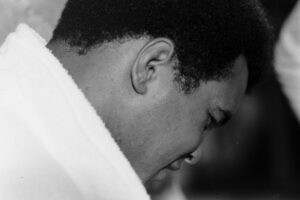For us textured-haired folk, “beauty sleep” isn’t just some cutesy term to say we need to catch some Zzzz’s.
Certainly, sleep is paramount, but we must also follow real nighttime hair rituals. And hair bonnets are typically high on the list of prescribed bedtime orders.
Made up of a tightly woven fabric of synthetic or natural fibers like polyester, rayon, or silk, hair bonnets are quite forgiving. Their smooth, malleable texture and natural drape moves with our hair, guarding it against damaging friction and dehydration. Our hairstyles remain well preserved, which saves us lots of time and hard-earned money.
As far as I’m concerned, a hair bonnet is one of the greatest gifts we can give to our hair, but its journey and evolution weren’t always to our benefit and convenience. It has a complex history and is an important part of the Black hair conversation.
Royal Beginnings
The research surrounding the original concept of hair coverings uncovers deeply rooted, symbolic expressions of Black pride and identity. Designed by women in sub-Saharan Africa in the early 1700s, they were primarily donned by powerful and royal queens across the continent to mark important stations in life, such as social status, wealth and spirituality.
The coverings were elaborately fashioned, made from the most exquisite fabrics and embellished with the most beautiful raw materials. Nubian queens chose rich fabrics, often adorned with exotic, colorful flowers. For special occasions, Nigerian queens preferred lighter, finely woven fabrics, while Egyptian royalty typically favored rich, densely woven textiles with intricate patterns.
Despite the dispersal of African communities on account of the Trans-Atlantic slave trade, these stunning emblems of African hair, fashion and honor prevailed during that time and space.
Over the Pond, A New Dress Code
By the 1700s, these special garments developed a very different meaning in the United States and across Europe. What had become a standard in women’s fashion, influenced by reverent ideals and an honorable badge of tradition and modesty, received a new symbolism, one that codified white supremacy.
In 1740, the Negro Act was passed in South Carolina, and while it outlawed slaves from assembling, learning to read, moving abroad, earning money and raising food, it also instituted guidelines for what they could wear. The dress codes reserved the cheapest fabrics for outdoor slaves, complete with bonnets made of scrap fabric tied at the chin. Indoor slaves wore those made in more elevated fabrics and designs, reflective of European styling.
Louisiana’s Forced “Edict of Good Government” in 1786, more commonly known as the Tignon Law, is another notable piece of the hair bonnet’s regal-turned-grim odyssey. Enacted by Governor Esteban Miro, the legislation disallowed Black women to style their hair in a preferred or attractive fashion. Instead, it was to be tied down by a “kerchief” or a “tignon”, a move driven by fear and jealousy.
Before the law’s passing, Creole women, in particular, had come to enjoy civil liberties over their darker-skinned, kinkier-haired brethren. Their features were measured as “closer” to Eurocentric standards of beauty and afforded them the privilege to interact with white society on a more equal footing. However, it resulted in a growing concern over white men finding biracial women more appealing, which infuriated white women. So, in an effort to distinguish social ranking (white women insisted on the head coverings to avoid any confusion over superiority), disparage commingling among the races, and to curb the white man’s lust, Black women were restricted to only wearing bonnets. But this dictatorship created a beautiful rebellion! Those Black women turned their bonnets (and other headwraps) into a creative source of self-expression and pride, fully fashioned with lush, vibrant fabrics trimmed with gorgeous feathers and jewels.

Sadly at the same time, the laws continued to embolden white society with the power to control the rules on attire for the Black population. It soon led to bonnets becoming negatively associated with dark-skinned, Black females. Depictions of bonnet-wearing stereotypes such as “Mammy” and Aunt Jemima were a reflection of their sole “place” in America: catering to the needs of white men, their mistresses’, children and their homes.
Function and Fashion
As the journey to freedom evolved, so did the increasingly tangled relationship Black women had with their hair. The start of the 20th century saw the introduction of chemical relaxers. While they were sorely looked upon by many African Americans for encouraging the desire to look “white”, societal pressures made them popular with Black women nonetheless. However, this led to head coverings like bonnets taking on more functional uses. They maintained the hairstyle, protecting it from dirt, debris and moisture.
Although chemical straighteners saw a decline during the Black Power movement of the 1960s and 1970s, it did not stop the popularity of hair coverings among Black women. Influenced by a reconnection to cultural roots and disempowering oppressive symbols, the bonnet’s styling was modified into an updated version of traditional headwraps. Civil rights icons like Nina Simone often performed for mixed audiences while wearing them as an act of revolt against social injustice.
Symbols of Pride
Today, Black women have reclaimed hair bonnets in a big way. And they are just as beautifully designed and as functional as ever. What was associated with some of the worst accounts of American history is, once again, an undeniable testament to who we are: resilient, resourceful and creative.
And while I might always consider a hair bonnet the workhorse in Black hair care, its meaning represents much more. It will never become just a piece of fabric we put on our heads.








